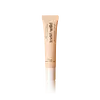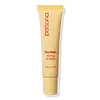What's inside
What's inside
 Key Ingredients
Key Ingredients

 Benefits
Benefits

 Concerns
Concerns

 Ingredients Side-by-side
Ingredients Side-by-side

Diisostearyl Malate
EmollientHydrogenated Polyisobutene
EmollientBis-Behenyl/Isostearyl/Phytosteryl Dimer Dilinoleyl Dimer Dilinoleate
EmollientPentaerythrityl Tetraethylhexanoate
EmollientMicrocrystalline Wax
Emulsion StabilisingSynthetic Fluorphlogopite
Dextrin Palmitate
EmulsifyingButyrospermum Parkii Butter
Skin ConditioningSilica Dimethyl Silylate
EmollientEthylene/Propylene/Styrene Copolymer
Synthetic Wax
AbrasiveEuphorbia Cerifera Wax
Squalane
EmollientPunica Granatum Seed Oil
EmollientHydrolyzed Hyaluronic Acid
HumectantCaprylic/Capric Triglyceride
MaskingTocopherol
AntioxidantButylene/Ethylene/Styrene Copolymer
Dehydroacetic Acid
PreservativeGlycine Soja Sterols
EmollientLinoleic Acid
CleansingPhospholipids
Skin ConditioningRosa Damascena Flower Oil
MaskingPentaerythrityl Tetra-Di-T-Butyl Hydroxyhydrocinnamate
AntioxidantWater
Skin ConditioningButylene Glycol
Humectant1,2-Hexanediol
Skin ConditioningNelumbium Speciosum Flower Extract
Skin ConditioningOligopeptide-1
Skin ConditioningGeraniol
PerfumingCitronellol
PerfumingDiisostearyl Malate, Hydrogenated Polyisobutene, Bis-Behenyl/Isostearyl/Phytosteryl Dimer Dilinoleyl Dimer Dilinoleate, Pentaerythrityl Tetraethylhexanoate, Microcrystalline Wax, Synthetic Fluorphlogopite, Dextrin Palmitate, Butyrospermum Parkii Butter, Silica Dimethyl Silylate, Ethylene/Propylene/Styrene Copolymer, Synthetic Wax, Euphorbia Cerifera Wax, Squalane, Punica Granatum Seed Oil, Hydrolyzed Hyaluronic Acid, Caprylic/Capric Triglyceride, Tocopherol, Butylene/Ethylene/Styrene Copolymer, Dehydroacetic Acid, Glycine Soja Sterols, Linoleic Acid, Phospholipids, Rosa Damascena Flower Oil, Pentaerythrityl Tetra-Di-T-Butyl Hydroxyhydrocinnamate, Water, Butylene Glycol, 1,2-Hexanediol, Nelumbium Speciosum Flower Extract, Oligopeptide-1, Geraniol, Citronellol
Triisostearin
Skin ConditioningHydrogenated Polyisobutene
EmollientPolyglyceryl-2 Triisostearate
EmulsifyingEthylhexyl Palmitate
EmollientDextrin Palmitate
EmulsifyingSqualane
EmollientDextrin Palmitate/Ethylhexanoate
EmulsifyingSorbitan Isostearate
EmulsifyingDiisostearyl Malate
EmollientSimmondsia Chinensis Butter
Skin ConditioningHelianthus Annuus Seed Oil
EmollientEthylhexylglycerin
Skin ConditioningPunica Granatum Flower Extract
Skin ConditioningPolyglyceryl-3 Diisostearate
EmulsifyingTribehenin
EmollientCarthamus Tinctorius Seed Oil
MaskingRicinus Communis Seed Oil
MaskingSimmondsia Chinensis Leaf Extract
HumectantSimmondsia Chinensis Seed Oil
EmollientTocopheryl Acetate
AntioxidantSodium Hyaluronate
HumectantAroma
Hydrogenated Castor Oil
EmollientLactic Acid
BufferingPrunus Persica Fruit Extract
AbrasiveVaccinium Angustifolium Fruit Extract
Skin ProtectingPalmitoyl Tripeptide-1
Skin ConditioningTriisostearin, Hydrogenated Polyisobutene, Polyglyceryl-2 Triisostearate, Ethylhexyl Palmitate, Dextrin Palmitate, Squalane, Dextrin Palmitate/Ethylhexanoate, Sorbitan Isostearate, Diisostearyl Malate, Simmondsia Chinensis Butter, Helianthus Annuus Seed Oil, Ethylhexylglycerin, Punica Granatum Flower Extract, Polyglyceryl-3 Diisostearate, Tribehenin, Carthamus Tinctorius Seed Oil, Ricinus Communis Seed Oil, Simmondsia Chinensis Leaf Extract, Simmondsia Chinensis Seed Oil, Tocopheryl Acetate, Sodium Hyaluronate, Aroma, Hydrogenated Castor Oil, Lactic Acid, Prunus Persica Fruit Extract, Vaccinium Angustifolium Fruit Extract, Palmitoyl Tripeptide-1
 Reviews
Reviews

Ingredients Explained
These ingredients are found in both products.
Ingredients higher up in an ingredient list are typically present in a larger amount.
Dextrin Palmitate comes from the palmitic acid ester of Dextrin. It is used as an emulsifier and texture enhancer.
Emulsifiers help keep ingredients together. According to a manufacturer, dextrin palmitate helps create a low-viscosity gel texture.
Due to its fatty acid base, this ingredient is not fungal-acne safe.
Learn more about Dextrin PalmitateDiisostearyl Malate is an emollient and most often used in lip products. It comes from isostearyl alcohol, a fatty acid, and malic acid, an AHA.
As an emollient, Diisostearyl Malate helps create a thin film on your skin to trap moisture in. This helps keep your skin soft and smooth.
Hydrogenated Polyisobutene is a synthetic polymer. Polymers are compounds with high molecular weight. Hydrogenated Polyisobutene is an emollient and texture enhancer.
In one study, Hydrogenated Polyisobutene showed better skin hydration levels than Caprylic/Capric Triglyceride. As an emollient, it helps keep your skin soft and hydrated by trapping moisture in.
Hydrogenated Polyisobutene is often used as a mineral oil replacement.
Learn more about Hydrogenated PolyisobuteneSqualane is an emollient that helps the skin hold onto moisture. It's an oily liquid that occurs naturally in certain types of fish and plant oils.
Because squalane boosts hydration in the skin, it also comes with plenty of benefits: it is an antioxidant and can help fight free radicals and skin damage. Squalane is also found to have a detoxifying effect when applied.
Squalane comes from squalene, which occurs naturally within the sebum of our skin. It is one of the oils our skin produces to keep itself hydrated. Squalane is the hydrogenated version of squalene and has a longer shelf life.
Research shows that squalane is non-irritating (even at 100% concentration).
In general, it's a fantastic ingredient. It does a great job at hydrating the skin, and it's suitable for those with sensitive skin.
The source of squalane may impact malassezia / fungal acne. This is because olive oil derived squalane can contain impurities such as fatty acids and plant waxes. Sugarcane derived squalane is recommended for anyone with malassezia concerns.
Is squalane vegan?
This depends on the source. Squalane can be derived from both plants and animals. Most squalane used in skincare comes from plants.
Please note: the source of squalane is only known if disclosed by the brand. We recommend reaching out to the brand if you have any questions about their squalane.
Read more about squalene with an "e".
Is squalane an oil?
Squalane is often called an oil, but it’s technically not; it’s a hydrocarbon, meaning it’s only made of carbon and hydrogen, unlike true oils which are triglycerides made of fatty acids and glycerol.
The term “oil-free” isn’t regulated, so companies can define it however they want. Some exclude all oils, while others just avoid mineral oil or comedogenic oils.
While some people avoid oils thinking they cause breakouts, the right kind of oil (or oil-like ingredient like squalane) can actually help balance and hydrate your skin. It’s worth testing out simple oils or squalane to see what works best for your skin.
Learn more about Squalane